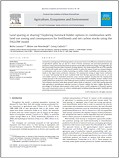| Journal Article |
 |
|
| Article Title | Land sparing or sharing? Exploring livestock fodder options in combination with land use zoning and consequences for livelihoods and net carbon stocks using the FALLOW model | | Author | Betha Lusiana, Meine van Noordwijk and Georg Cadisch | | Year | 2012 | | Journal Title | Agriculture, Ecosystems and Environment | | Institution | Elsevier B.V. | | Volume | 159 | | Issue | 2012 | | Pages | 145– 160 | | Call Number | JA0453-12 | | Keywords | Carbon stocks livelihood trade-offs, Land sharing versus sparing, Land use zoning, Model of ruminant cut-carry systems, Scenario analysis |
|
| Abstract: |
| Livestock as an integral part of farming systems can increase resource use efficiency and land use intensity
of agricultural systems, but can also be a driver of forest conversion and associated greenhouse gas
emissions. Forest policies that limit land use options may be able to halt forest change, if strongly enforced,
but concurrently may also reduce livestock carrying capacity. This study explored the use of the spatially
explicit FALLOW model, with a new livestock module, to assess the impact of land use zoning strategies,
in combination with access to fodder harvesting, on welfare, fodder availability and landscape carbon
stocks in the Upper Konto catchment, Indonesia. The existing land zoning in Upper Konto catchment
is in name ‘land-sparing’ but de facto combined with ‘land sharing’ approach with access to cut and
carry fodder sources in watershed protection areas. Scenario analysis revealed that the existing land
zoning approach is the most promising in terms of balancing fodder availability, farmers’ welfare (total
profits gained from production in the landscape minus products consumed by people living in the area)
and ecosystem functions (with above-ground carbon stocks as indicator). A pure land sparing approach
with agricultural intensification indicates increase in farmers’ welfare but with a higher decrease (in
percentage) of landscape above-ground carbon stocks. Hence, careful integration of livestock systems
into zoned conservation areas can achieve multiple goals including enhancing peoples’ livelihoods and
protecting environmental services. |
|
|
Download file(s): Click icon to download/open file.
|
|
|
|
|
| Viewed in 2079 times. Downloaded in 0 times. |